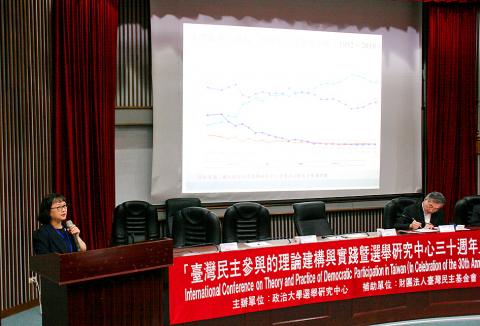Most Taiwanese see Taiwan and China as distinct nations, despite cultural similarities, a study released yesterday by National Chengchi University’s Election Study Center showed.
Center researcher Cheng Su-feng (鄭夙芬) revealed the results on the first day of a two-day academic symposium in Taipei on Taiwan’s democratization and free elections. It also marked the center’s 30th anniversary.
The study on the national identity of Taiwanese, which involved interviews conducted between 2000 and 2016, has found that while most people considered China to be the source of much of Taiwan’s culture, they considered China to be a separate country, Cheng said.

Photo: CNA
The research showed that while a collective identity had not yet taken shape in the nation, Taiwanese largely saw Taiwan as a country, she said.
While most felt that there was a connection with China based on migration and shared cultural elements, there was a portion of the public that conversely cited cultural differences as making the two nations distinct, Cheng said.
The study found that a growing number of Taiwanese view the People’s Republic of China (PRC) as a distinctly separate country from the Republic of China (ROC), but there is a number of people who consider Taiwan as a part of “China,” without specifying whether they mean the PRC or the ROC, she said.
The study showed that Taiwan is still in a state of change, but a majority refer to themselves as Taiwanese to specify that they were born and raised in Taiwan, she said, adding that they also agreed that they were “willing to make contributions on behalf of Taiwan.”
“Looking at the discourse in Taiwan from the past 10 years describing Taiwan and China as opposing countries, it is clear that [seeing Taiwan as a separate country] has already become the mainstream,” Cheng said.

LIMITS: While China increases military pressure on Taiwan and expands its use of cognitive warfare, it is unwilling to target tech supply chains, the report said US and Taiwan military officials have warned that the Chinese People’s Liberation Army (PLA) could implement a blockade within “a matter of hours” and need only “minimal conversion time” prior to an attack on Taiwan, a report released on Tuesday by the US Senate’s China Economic and Security Review Commission said. “While there is no indication that China is planning an imminent attack, the United States and its allies and partners can no longer assume that a Taiwan contingency is a distant possibility for which they would have ample time to prepare,” it said. The commission made the comments in its annual

DETERMINATION: Beijing’s actions toward Tokyo have drawn international attention, but would likely bolster regional coordination and defense networks, the report said Japanese Prime Minister Sanae Takaichi’s administration is likely to prioritize security reforms and deterrence in the face of recent “hybrid” threats from China, the National Security Bureau (NSB) said. The bureau made the assessment in a written report to the Legislative Yuan ahead of an oral report and questions-and-answers session at the legislature’s Foreign Affairs and National Defense Committee tomorrow. The key points of Japan’s security reforms would be to reinforce security cooperation with the US, including enhancing defense deployment in the first island chain, pushing forward the integrated command and operations of the Japan Self-Defense Forces and US Forces Japan, as

‘TROUBLEMAKER’: Most countries believe that it is China — rather than Taiwan — that is undermining regional peace and stability with its coercive tactics, the president said China should restrain itself and refrain from being a troublemaker that sabotages peace and stability in the Indo-Pacific region, President William Lai (賴清德) said yesterday. Lai made the remarks after China Coast Guard vessels sailed into disputed waters off the Senkaku Islands — known as the Diaoyutai Islands (釣魚台) in Taiwan — following a remark Japanese Prime Minister Sanae Takaichi made regarding Taiwan. Takaichi during a parliamentary session on Nov. 7 said that a “Taiwan contingency” involving a Chinese naval blockade could qualify as a “survival-threatening situation” for Japan, and trigger Tokyo’s deployment of its military for defense. Asked about the escalating tensions

The Ministry of Economic Affairs said it plans to revise the export control list for strategic high-tech products by adding 18 items under three categories — advanced 3D printing equipment, advanced semiconductor equipment and quantum computers — which would require local manufacturers to obtain licenses for their export. The ministry’s announcement yesterday came as the International Trade Administration issued a 60-day preview period for planned revisions to the Export Control List for Dual Use Items and Technology (軍商兩用貨品及技術出口管制清單) and the Common Military List (一般軍用貨品清單), which fall under regulations governing export destinations for strategic high-tech commodities and specific strategic high-tech commodities. The